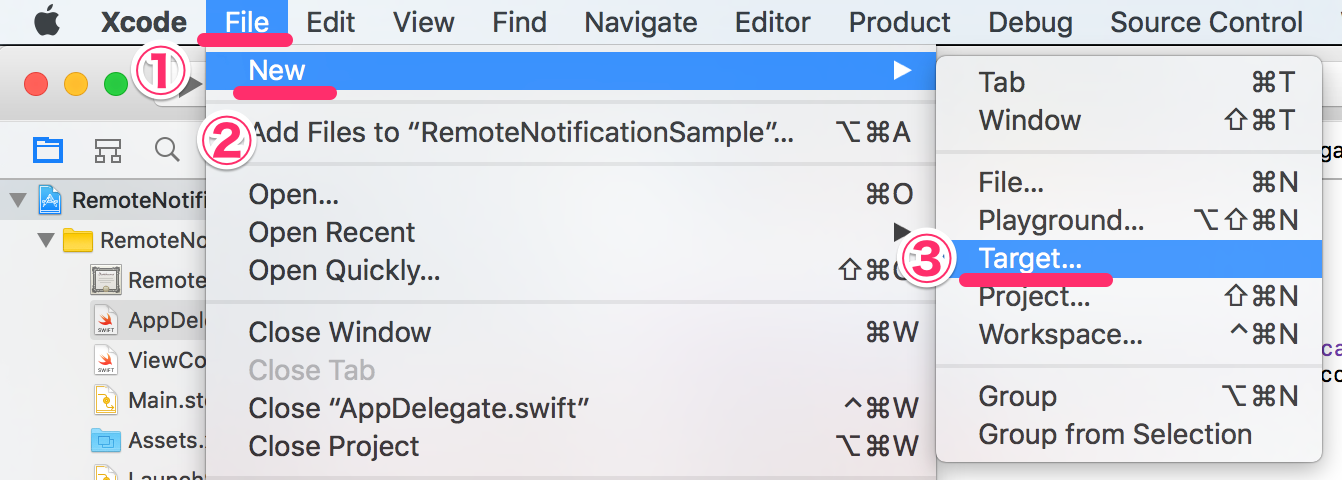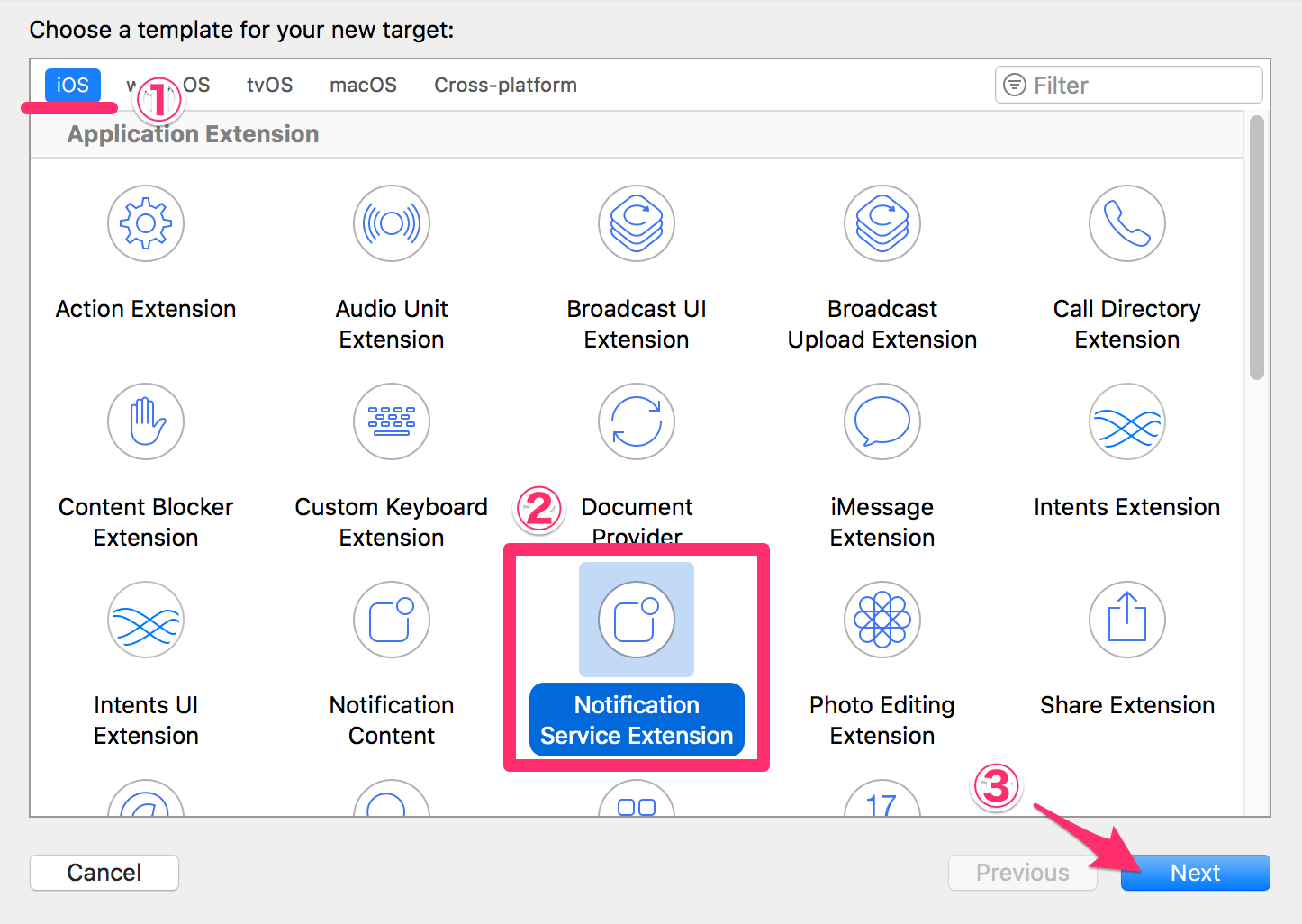Push Notification for iOS¶
Settings for Push Notification¶
See Settings for APNs Certificate (iOS) to setup.
Removing the push notification badge from your app icon¶
By checking 'Show badge icon' in the 'Create New Push Notification' form, a badge icon is automatically shown above the icon of your app.
The way to remove the badge depends on the iOS version and requires setting either of the following to 0
Class attribute setBadgeCount of
UNUserNotificationCenterClass attribute applicationIconBadgeNumber of
UIApplication
Set 0 to setBadgeCount or applicationIconBadgeNumber at any timing according to the application specifications.
For example if you want to remove the badge every time the app gets activated, you should implement the following in the delegate method applicationDidBecomeActive: of UIApplicationDelegate.
// AppDelegate.m
@implementation AppDelegate
- (void)applicationDidBecomeActive:(UIApplication *)application
...
if (@available(iOS 16.0, *)) {
UNUserNotificationCenter *center = [UNUserNotificationCenter currentNotificationCenter];
[center setBadgeCount:0];
} else {
application.applicationIconBadgeNumber = 0;
}
...
// AppDelegate.swift
class AppDelegate: UIResponder, UIApplicationDelegate, UNUserNotificationCenterDelegate {
func applicationDidBecomeActive(_ application: UIApplication) {
...
if #available(iOS 16.0, *) {
let center = UNUserNotificationCenter.current()
center.setBadgeCount(0)
} else {
application.applicationIconBadgeNumber = 0
}
...
Note
If you enable the 'Show badge icon' option, you should always implement a way to remove the badge icon as well.
Note
Executing the way to remove the badge icon when the badge is displayed on the app icon will change the behavior depending on the way. If the badge is not displayed, nothing will happen by executing the way to remove the badge icon.
setBadgeCount: If set to 0, the badge will be removed, but notifications remaining in the Notification Center will not be removed.applicationIconBadgeNumber: If set to 0, the badge will be removed and any remaining notifications in the Notification Center will also be deleted.
Send Device Token to Repro¶
Send Device token and Registration ID to Repro to use push notification.
Turn on Push Notifications from Capabilities in Xcode.

Next, add the following code.
// AppDelegate.m
#import <Repro/Repro.h>
#import <UserNotifications/UserNotifications.h>
...
@implementation AppDelegate
- (BOOL)application:(UIApplication *)application didFinishLaunchingWithOptions:(NSDictionary *)launchOptions {
...
if (floor(NSFoundationVersionNumber) > NSFoundationVersionNumber_iOS_9_x_Max) {
UNUserNotificationCenter *center = [UNUserNotificationCenter currentNotificationCenter];
center.delegate = self;
[center requestAuthorizationWithOptions:(UNAuthorizationOptionAlert | UNAuthorizationOptionBadge | UNAuthorizationOptionSound) completionHandler:^(BOOL granted, NSError * _Nullable error) {
}];
[[UIApplication sharedApplication] registerForRemoteNotifications];
} else {
UIUserNotificationType types = UIUserNotificationTypeBadge | UIUserNotificationTypeSound | UIUserNotificationTypeAlert;
UIUserNotificationSettings *settings = [UIUserNotificationSettings settingsForTypes:types categories:nil];
[[UIApplication sharedApplication] registerUserNotificationSettings:settings];
[[UIApplication sharedApplication] registerForRemoteNotifications];
}
return YES;
}
// AppDelegate.swift
import Repro
import UserNotifications
...
class AppDelegate: UIResponder, UIApplicationDelegate, UNUserNotificationCenterDelegate {
...
func application(_ application: UIApplication, didFinishLaunchingWithOptions launchOptions: [UIApplicationLaunchOptionsKey: Any]?) -> Bool {
...
if #available (iOS 10.0, *) {
let center = UNUserNotificationCenter.current()
center.delegate = self
center.requestAuthorization(options: [.sound, .alert, .badge], completionHandler: { (granted, error) in
})
application.registerForRemoteNotifications()
} else {
let settings: UIUserNotificationSettings = UIUserNotificationSettings(types: [.alert, .badge, .sound], categories: nil)
UIApplication.shared.registerUserNotificationSettings(settings)
UIApplication.shared.registerForRemoteNotifications()
}
return true
}
// AppDelegate.m
- (void)application:(UIApplication *)application didRegisterForRemoteNotificationsWithDeviceToken:(NSData *)deviceToken
{
[Repro setPushDeviceToken:deviceToken];
}
- (void)application:(UIApplication *)application didFailToRegisterForRemoteNotificationsWithError:(NSError *)error
{
NSLog(@"Remote Notification Error: %@", error);
}
// AppDelegate.swift
func application(_ application: UIApplication, didRegisterForRemoteNotificationsWithDeviceToken deviceToken: Data) {
Repro.setPushDeviceToken(data: deviceToken)
}
func application(_ application: UIApplication, didFailToRegisterForRemoteNotificationsWithError error: Error) {
print("Remote Notification Error: \(error)")
}
application:didRegisterForRemoteNotificationsWithDeviceToken: method will be called when it succeeds to receive the device token, so please pass the device token to Repro inside there.
When it fails to receive device token, application:didFailToRegisterForRemoteNotificationsWithError: method will be called, so please handle the error accordingly.
After implementing above code and launch your app, you will see a dialog asking for permission for the push notification.

When you choose OK on this dialog, device token will be set with the application didRegisterForRemoteNotificationsWithDeviceToken: method, and the device becomes eligible to receive push notifications.
Once you finished all above steps, preparation for push notification is all completed.
Option: setup to receive Rich Notification¶
Rich notification feature has been added to iOS 10 which allows you to use image, video and audio file for the notification. Receiving rich notification requires the steps below.
Create Notification Service Extension¶
Click File -> New -> Target... from your Xcode menu.

Click iOS -> Notification Service Extension -> Next.

Fill in Product Name and click Finish.

Click Activate if you see a dialog like the below:

Implement Notification Service Extension¶
Write the below in Notification Service Extension.
#import <UserNotifications/UserNotifications.h>
...
@implementation NotificationService
- (void)didReceiveNotificationRequest:(UNNotificationRequest *)request withContentHandler:(void (^)(UNNotificationContent * _Nonnull))contentHandler {
self.contentHandler = contentHandler;
self.bestAttemptContent = [request.content mutableCopy];
NSDictionary *attachment = request.content.userInfo[@"rpr_attachment"];
if (!attachment) {
contentHandler(self.bestAttemptContent);
return;
}
NSString *urlStr = attachment[@"url"];
NSString *type = attachment[@"type"];
NSURL *url = [NSURL URLWithString:urlStr];
[[[NSURLSession sharedSession] downloadTaskWithURL:url
completionHandler:^(NSURL * _Nullable location,
NSURLResponse * _Nullable response,
NSError * _Nullable error) {
if (error) {
contentHandler(self.bestAttemptContent);
return;
}
NSString *fileName = [NSString stringWithFormat:@"%@.%@", [[NSUUID UUID]UUIDString], type];
NSURL *fileURL = [NSURL fileURLWithPath:[NSTemporaryDirectory() stringByAppendingPathComponent:fileName]];
[[NSFileManager defaultManager] moveItemAtURL:location toURL:fileURL error:nil];
NSError *attachError = nil;
UNNotificationAttachment *attachment = [UNNotificationAttachment attachmentWithIdentifier:@"IDENTIFIER" URL:fileURL options:nil error:&attachError];
if (!attachError) {
self.bestAttemptContent.attachments = @[attachment];
}
contentHandler(self.bestAttemptContent);
}] resume];
}
import UserNotifications
...
class NotificationService: UNNotificationServiceExtension {
var contentHandler: ((UNNotificationContent) -> Void)?
var bestAttemptContent: UNMutableNotificationContent?
override func didReceive(_ request: UNNotificationRequest, withContentHandler contentHandler: @escaping (UNNotificationContent) -> Void) {
self.contentHandler = contentHandler
bestAttemptContent = (request.content.mutableCopy() as? UNMutableNotificationContent)
if let attachment = request.content.userInfo["rpr_attachment"] as? [String: String] {
if let urlString = attachment["url"], let fileURL = URL(string: urlString), let type = attachment["type"] {
URLSession.shared.downloadTask(with: fileURL) { (location, response, error) in
if let location = location {
let fileName = UUID().uuidString + "." + type
let tmpFile = "file://".appending(NSTemporaryDirectory()).appending(fileName)
let tmpUrl = URL(string: tmpFile)!
try? FileManager.default.moveItem(at: location, to: tmpUrl)
if let attachment = try? UNNotificationAttachment(identifier: "IDENTIFIER", url: tmpUrl, options: nil) {
self.bestAttemptContent?.attachments = [attachment]
}
}
contentHandler(self.bestAttemptContent!)
}.resume()
}
} else {
contentHandler(self.bestAttemptContent!)
}
}
After finishing the above implementation, see Create Push Notification.
Option: Using Universal-Links¶
It is possible to custom handle the opening of Universal-Links (also called App-Links) when Push Notifications or In-App Messages are tabbed. (For simplification from now only called Universal-Links.)
Please follow the examples below in order to add a custom Universal-Link callback handler which is executed every time an Universal-Link would be opened from a Push-Notification or In-App Message.
How to register a regular expression to match Universal-Links.¶
In order to use Universal-Link callbacks, a regular expression based url matcher must be added.
Note
When a pattern (regular expression) is matched, the callback process described below is kicked to the URL set as the destination for opening a push notification or a message in the application.
When HTML content is displayed in in-app messages, universal linking is also determined for requests that occur within that content.
For iOS apps, these matcher regular expressions can be added in the AppDelegate or in the Apps designated .plist file. For Android apps your class that extents Application can be used or if that is not possible, the regular expressions can also be added to your AndroidManifest.xml file.
// AppDelegate.m
#import <Repro/Repro.h>
- (BOOL)application:(UIApplication *)application didFinishLaunchingWithOptions:(NSDictionary *)launchOptions
{
[Repro addOpenUrlFilterRegEx:@"https://example\\.com/page/"];
[Repro addOpenUrlFilterRegEx:@"your-domain\\.com/.+\?universal=true"];
...
}
// .plist file
/*
<dict>
<key>RPROpenUrlFilterRegExList</key>
<array>
<string>https://example\.com/page/</string>
<string>your-domain\.com/.+\?universal=true</string>
</array>
...
</dict>
*/
// MyApplication.java
import io.repro.android.Repro;
public class MyApplication extends Application {
@Override
public void onCreate() {
super.onCreate();
Repro.addOpenUrlFilterRegEx("https://example\\.com/page/");
Repro.addOpenUrlFilterRegEx("your-domain\\.com/.+\\?universal=true");
...
}
...
}
// AndroidManifest.xml
// To specify multiple URL patterns, enter them separated by commas.
<application>
...
<meta-data
android:name="io.repro.android.OpenUrlFilterRegExList"
android:value="https://example\\.com/page/;your-domain\\.com/.+\\?universal=true">
</meta-data>
</application>
// MyApplication.kt
import io.repro.android.Repro
class MyApplication : Application() {
override fun onCreate() {
super.onCreate()
Repro.addOpenUrlFilterRegEx("https://example\\.com/page/")
Repro.addOpenUrlFilterRegEx("your-domain\\.com/.+\\?universal=true")
...
}
...
}
// AndroidManifest.xml
// To specify multiple URL patterns, enter them separated by commas.
<application>
...
<meta-data
android:name="io.repro.android.OpenUrlFilterRegExList"
android:value="https://example\\.com/page/;your-domain\\.com/.+\\?universal=true">
</meta-data>
</application>
// AppDelegate.swift
func application(_ application: UIApplication, didFinishLaunchingWithOptions launchOptions: [UIApplication.LaunchOptionsKey: Any]?) -> Bool
{
Repro.add(openUrlFilterRegEx: "https://example\\.com/page/")
Repro.add(openUrlFilterRegEx: "your-domain\\.com/.+\\?universal=true")
...
}
// .plist file
/*
<dict>
<key>RPROpenUrlFilterRegExList</key>
<array>
<string>https://example\.com/page/</string>
<string>your-domain\.com/.+\?universal=true</string>
</array>
...
</dict>
*/
Please follow native iOS and Android instructions in order to add the filters
to the plist/AndroidManifest files or the main AppDelegate/Application classes.
Please follow native iOS and Android instructions in order to add the filters
to the plist/AndroidManifest files or the main AppDelegate/Application classes.
// YourAppNameScene.cpp
bool YourAppName::init() {
ReproCpp::addOpenUrlFilterRegEx("https://example\\.com/page/");
ReproCpp::addOpenUrlFilterRegEx("your-domain\\.com/.+\\?universal=true");
...
}
Please follow native iOS and Android instructions in order to add the filters
to the plist/AndroidManifest files or the main AppDelegate/Application classes.
Please follow native iOS and Android instructions in order to add the filters
to the plist/AndroidManifest files or the main AppDelegate/Application classes.
Warning
Specify the URL pattern to be set as a universal link as concretely as possible, including the domain and path , and should be all in lowercase .
If only a scheme is specified, such as https, a request made by a script executed in a screen displayed by an in-app message may be mistakenly judged as a universal link, and callback processing may be executed at an unintended timing.
If uppercase letters are used in the scheme/domain portion of the URL pattern, the scheme/domain portion is automatically converted to lowercase and processed when attempting to use a universal link to transition from a button displayed in an HTML in-app message. The pattern (regular expression) may not match and callback processing may not be executed at the intended timing.
Adding a callback handler for opening Universal-Links¶
Next a callback handler for custom processing of Universal-Links is added. The URL that was about to be opened is passed to the callback, where then depending on the URL custom code can be executed.
#import <Repro/Repro.h>
...
- (BOOL)application:(UIApplication *)application didFinishLaunchingWithOptions:(NSDictionary *)launchOptions
{
[Repro setOpenUrlCallback:^(NSURL *url) {
if ([url.host isEqualToString:@"example.com"]) {
// In case of your universal link perform navigation, present content, ...
handleUniversalLink(url);
}
}];
...
[Repro setup:@"YOUR_APP_TOKEN"];
...
}
// Set a callback that is executed everytime an URL is about to be opened
Repro.setOpenUrlCallback { url in
if url.host == "example.com" {
// In case of your universal link perform navigation, present content, ...
handleUniversalLink(url)
}
}
...
Repro.setup(token: "YOUR_APP_TOKEN")
...
import io.repro.android.Repro;
public class MyApplication extends Application {
@Override
public void onCreate() {
super.onCreate();
// In order to execute a callback when a push notification is tapped,
// the callback must be set in Application, not Activity.
Repro.setOpenUrlCallback(new Repro.OpenUrlCallback() {
// ** This callback method is executed in the main thread **
@Override
public void onOpened(Uri uri) {
if ("example.com".equals(uri.getHost())) {
// In case of your universal link perform navigation, present content, ...
}
}
});
...
Repro.setup(this, YOUR_APP_TOKEN);
...
}
...
}
import io.repro.android.Repro
class MyApplication : Application() {
override fun onCreate() {
super.onCreate()
// In order to execute a callback when a push notification is tapped,
// the callback must be set in Application, not Activity.
Repro.setOpenUrlCallback { uri ->
// ** This callback method is executed in the main thread **
if (uri.host == "example.com") {
// In case of your universal link perform navigation, present content, ...
}
}
...
Repro.setup(this, "YOUR_APP_TOKEN")
...
}
...
}
Repro.setOpenUrlCallback((uri) { // uri is of type Uri
debugPrint("Universal Link Callback Handler received: " + uri.toString());
});
// Somewhere before Repro.Setup(...)
Repro.SetOpenUrlCallback(uri => // uri is of type Uri
{
Debug.Log("Universal Link Callback Handler received: " + uri.ToString());
});
bool YourAppName::init() {
ReproCpp::addOpenUrlFilterRegEx(...);
ReproCpp::setOpenUrlCallback([](const char *url) {
if (strcmp(url, "example.com") == 0) {
// In case of your universal link perform navigation, present content, ...
}
});
ReproCpp::setup("YOUR_APP_TOKEN")
...
}
Repro.setOpenUrlCallback(function(url) { // url is of type String
alert('Universal Link Callback Handler received: ' + url);
if (url.includes("http://example.org")) {
// In case of your universal link perform navigation, present content, ...
}
});
Repro.setOpenUrlCallback( (url) => { // url is of type String
console.log('Universal Link Callback Handler received: ' + url);
if (url.includes("http://example.org")) {
// In case of your universal link perform navigation, present content, ...
}
});
